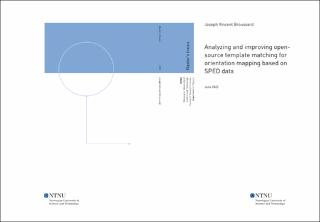| dc.description.abstract | Science has become and continues to be more reliant on fast, accurate, precise and understandable computational methods. Most scientific communities have been gravitating towards open source python packages, as python is more generally readable and understandable than most compiled languages, and electron microscopy is no different. With the wealth of open source packages available comes a necessity to test the limitations and efficacy of these packages. Here the python package Pyxem, built upon the Hyperspy library, is of interest due to recent developments in fast template matching of scanning precession electron diffraction data. In template matching an experimental electron diffraction pattern is compared to a bank of simulated templates, for example for different orientations of the candidate crystal. The question then becomes if the template matching approach for orientation analysis can be further optimized in regards to accuracy of the found final result. The new fast functionality allows for the systematic study of acquisition parameters such as camera length and processing steps such as background subtraction. Both simulated and experimental data sets, the later based on scanning precession electron diffraction of face-centered cubic materials, are utilized for these parameter tests. It is found that the camera length should be as small as experimentally reasonable to maximize to amount of diffraction spots. Further, logarithmic intensity scaling should be used with background subtraction in the form of difference of gaussians. It is also observed that the accuracy of the results is uneven across orientation space. In addition, tilt series are used as input. These prove useful, as in an experimental data set, as the found crystal orientation can be compared to the known experimental tilt step, a reference area that can be template matched more robustly or a known orientation relationship, as is the case with identifiable twin boundaries. Instead of comparing the cross-correlation score between experimental and simulated template, the misorientation angle between the template matched results and the expected value can be used as matching quality parameter. In addition, mis-indexations can be identified and the accuracy of the method as a whole quantified. Open source based template matching has allowed for speeding up and improving template matching and will lead to the technique being more utilized and its results being fairly valued. | |
